The ATF refers to the Remington V3 TAC-13, Garaysar Fear-118, and Armscor VRF14 as “firearms.” Technically speaking, the Remington, Armscor, and Garaysar are not pistols, nor rifles, nor shotguns. What makes them a firearm and not a rifle, pistol, or shotgun is the overall length. If the overall length of a gun is 26 inches or less, it becomes just a firearm. So humor us and we’ll call them firearms, though in our world, if it shoots shotgun shells, it’s a shotgun.
Our three firearms have barrels that range from 14 to 14.5 inches, are chambered in 12 gauge, and use a gas-piston-driven semi-automatic action. The Garaysar and Remington look like an abbreviated bird gun with the short barrel, bird’s head grip, and tube magazine. In hand, these two firearms are like a big stick, and loaded with 00 Buck, that stick weighs more than 6 pounds. Firing these guns most effectively requires two hands. But because the bird’s head grip is almost parallel with the action, you can fire these guns one handed. However, your follow-up shot may be more skyward than on target. With these firearms, the shooter points rather than aims them with a shooting hand on the grip and pulling in rearward. The front support hand on the fore end curls the thumb over the top of the barrel, pushing forward. This push/pull technique allows recoil to come straight back, and the shooter can easily manage muzzle flip, even with the hot Hornady Critical Defense loads that have 1600 fps muzzle velocity. Because of their linear profile, the V3 and Fear-118 are more concealable than the Armscor and are easier to maneuver in a vehicle or in a narrow hallway and around doors.
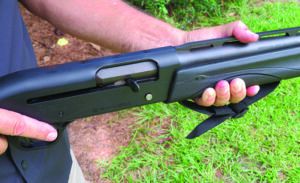
In contrast, the VRF14 is designed like an AR pistol with a removable box magazine, AR-style pistol grip, and Picatinny rails. It is heavy — and that’s a good thing for controlling this 12-gauge beast — and less compact, though still concealable. This shotgun also requires more technique to shoot effectively, which we’ll get into.
We wanted to look at these firearms, aka shotguns, through the lens of a home-defense gun and vehicle gun. A 5.11 LV M4 Shorty ($125; 511Tactical.com) was used as a discreet, low-visibility vehicle case. All three shotguns fit in the case, and the case can be worn as a backpack or as a crossbody bag plus. It also has a grab handle, so you can carry it like a typical long-gun bag. A strap attached to MOLLE webbing inside the case keeps the weapon in place. There is a large and small outside pocket to store other EDC go-bag-type gear. The large pocket has MOLLE webbing in it so you can add magazine pouches. This bag can also be used to carry a disassembled AR. We attached two 5.11 five-round shotgun carriers ($39). These two strips attached to the MOLLE inside the case and gave us 10 additional shells for reloading without fumbling for loose rounds in pockets. We found that, with practice, we could draw the Remington and Garaysar from the bag relatively fast. With the Armscor, we had to take off the bag, remove the gun, and insert a magazine. For a less discreet carry, we opted for a 19-inch Tactical Shotgun Scabbard ($32; Amazon.com), which has MOLLE webbing on both sides so you can attach it to the sides or back of a backpack or, with the sling, you can wear it crossbody. It has four shell holders, and it worked with the Garaysar and Remington, but not the Armscor. Slung over the shoulder, the scabbard slid down our backs so the grip was not accessible for an over-the-shoulder draw. We found that if we held the bottom of the scabbard or sling with our support hand, we could pull the shotguns out with our shooting hand over the shoulder. The scabbard is less secure than a holster, but it allows the shooter to easily transport the tube-magazine guns with a reload. Notably, the Fear-118 fit the scabbard, even with its extended charging handle.
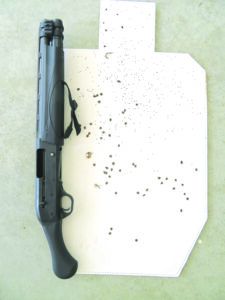
Test ammo consisted of all 23⁄4-inch shells with 00 buckshot loads from Hornady Critical Defense, Aguila, and Sellier & Bellot. We also tested bird shot in a high-velocity load with No. 71⁄2 shot from Fiocchi. We wanted to see if a less penetrating load like the bird shot would produce tight patterns in the event of a home invasion. Bird shot offers less penetration than buck shot and that could be a consideration if you have family living with you. Sheetrock acts like tissue paper when buck shot passes through it, and the shot still has power to inflict grave injuries. We also used some light target loads to see if any of the gas system would choke. The Armscor did, but only because we had the high-velocity gas piston and spring installed.
Our first round of tests was fired on a tombstone target set on a stand about five feet off the ground. We fired one and two handed and from the hip with all shotguns. We also shot for speed to see how recoil impacted our ability to control these beasts for follow-up shots. The Remington and Garaysar were easier to shoot. The Armscor took more technique.
The second series of tests looked at shot patterns. As much as it sounds cool to say these shotguns are hallway sweepers, they can surgically deliver loads, and depending on the load and distance, keep that pattern well within an 18-inch-wide target, such as the average width of the human torso. Read on to get more details on these shotshell firearms.
Gun Tests Grade: A
$1900
Remington firearms are slowly coming back since the company’s bankruptcy, and used TAC-13s are worth their weight in gold, some selling for $2k. Our sample was procured prior to the collapse of Big Green. Current average price is little over $1k.
| Action Type | Semi-auto, gas operated |
| Chamber Size | 3.0 in. |
| Overall Length | 26.5 in. |
| Magazine Type | Fixed tube |
| Capacity | 5+1 |
| Weight Unloaded | 5.9 lbs. |
| Weight Loaded | 6.4 lbs. |
| Barrel Length | 13.0 in. |
| Finish | Black oxide |
| Choke | Cylinder Bore |
| Grip | Bird’s head-style, textured polymer w/QD socket |
| Fore End | Textured polymer w/nylon strap |
| Front Sight | Bead |
| Trigger Pull Weight | 5.4 lbs. |
| Safety | Manual trigger block |
| Warranty | None |
| Telephone | (844) 736-2767 |
| Website | RemArms.com |
| Made In | U.S.A. |
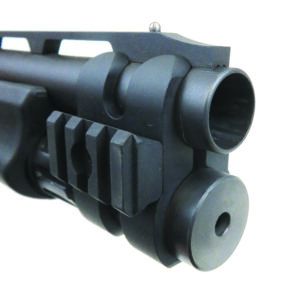
The V3 action uses twin gas pistons similar to Remington’s Versa Max gas system, but is less complicated, with fewer parts. There are eight gas ports near the breech that allow the gas to work the pistons. If you shoot a 3-inch shell, four ports are open; shoot 23⁄4-inch shells and eight ports are open. Excess gas is bled off via the forearm. This is a very clean gas system. The dual recoil springs are inside the receiver, unlike other gas-system designs where the recoil spring is in the stock.
A magazine cut-off allows the shooter to slide a button on the trigger guard forward to block the magazine and remove the shell in the chamber. This can be handy to make the TAC-13 safe during transport as well as give the user the ability to hold onto bird shot in the magazine tube and feed 00 buck shells or slugs one at a time, as needed.
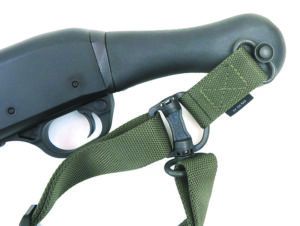
At first, the vent rib seems like an afterthought, but its job is to keep your hand off the barrel that heats up fast. At the business end is a small Picatinny rail for a tactical light or laser sight on the right side and swivel stud on the left side. The receiver is drilled and tapped if you want to add a red-dot sight. In our opinion, there is no need for a red-dot sight because the Remington is not built for pinpoint shooting. The left side of the bird’s-head grip has a QD attachment socket, which we found handy.
You can carry the TAC-13 via a single-point sling similar to how you’d carry an AR carbine. We used a Magpul MS4 Dual QD Sling Gen2 ($50; HCCTac.com) and a Blue Force Vickers 221 Sling ($93; BlueForceGear.com) like you might use to carry an AR carbine or AR pistol. Both of these slings allow for fast one-hand sling adjustment. The TAC-13 was comfortable to carry this way. We tried to create a steadier aim using the sling in the push/pull shooting technique, but the abbreviated TAC-13 shotgun was too long, and if we adjusted the sling smaller, it was uncomfortable to wear.
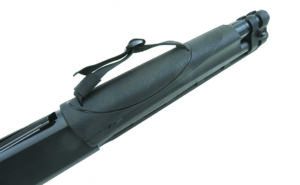
Both slings are made of nylon that was wide enough to support the TAC-13 without digging into our neck and shoulder. Both use plastic buckles and push-button QD swivels. They were easy to get into and out of. With the TAC-13 on the sling, it balanced well and pointed downward, allowing us to use our hands for other tasks. The way these slings are designed is for fast adjustment that stays put and no flopping loose ends to get tangled up.
We’d prefer to carry the TAC-13 discreetly in the 5.11 case, though it is bulkier. Because the trigger guard is exposed in the scabbard, we would keep the chamber empty and rack a shell in the chamber after drawing it from the scabbard.
To load, lock back the bolt, drop a shell in the chamber and slam the bolt home via the bolt-release button located on the right side of the receiver, just below the operating handle. Now push five shells into the internal tube magazine, and it time to unleash the beast. The edges around the ejection port and loading ports were smooth, no sharp edges. The end of the carrier was rounded too, so it didn’t bite the shooter’s thumb as he pushed a shell home in the magazine.
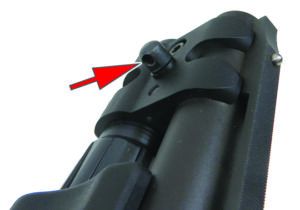
Once at the range, we noticed the trigger had about 1⁄8 inch of take up before it hit the wall and broke at reasonable 5.4 pounds. Starting with a low-velocity 23⁄4-inch target load, we wanted to see if the TAC-13 would choke on the soft-shooting load. It didn’t. In fact, the TAC-13 operated without issue with all shells. The Fiocchi No. 71⁄2 bird shot gave a pattern that measured 13 inches at 15 yards. The pattern would be tighter at closer range, so this would be a good in-home defense load. Moving to 00 buck, the Aguila and Hornady both punched tight patterns, 4 and 4.5 inches, respectively. Again, these are nice tight patterns for close-range work, and if you are not concerned with overpenetration, any of these shells is a good option. The Sellier & Bellot pattern was more than double that at 9 inches, which means pellets may not hit the target if you are not aiming exactly for center of mass. The more distance you are away from the target, the wider the pattern and the less effective the shot will be. There’s also a liability issue if you fire a shotgun and pellets miss the target, causing collateral damage.
Using the push/pull method, we were able to easily fire the TAC-13 and manage recoil, even when we emptied the magazine tube as fast as we could pull the trigger. The nylon strap was very handy, allowing us take control of and hang on to the TAC-13 as it coughed out mouthfuls of 00 buck shot. We found the action surprisingly smooth to operate and cycle. The operating lever is a similar size to the one on the bird-hunting V3 semi-auto shotgun. This was a soft-recoiling firearm.
Our Team Said: The TAC-13 is a well-thought “firearm” that offers a lot of features and plenty of 12-gauge firepower with less recoil. For a short-range home-defense weapon or vehicle gun, this is an excellent option.
Range Data
All shotshells were 2.75 inches in length. Patterns were measured at 15 yards.| Hornady Critical Defense 00 Buckshot | Sellier & Bellot 00 Buckshot | Aguila 00 Buckshot | Fiocchi No. 71⁄2 shot | ||
|---|---|---|---|---|---|
| Armscor VRF14 | 3.0 in. | 9.0 in. | 7.0 in. | 21.0 in. | |
| Garaysar Fear-118 (Full Choke) | 8.0 in. | 3.3 in. | 4.5 in. | 6.0 in. | |
| Remington V3 TAC-13 | 4.5 in. | 9.0 in. | 4.0 in. | 13.0 in. |
Value Guide: Self Defense Shotgun Rankings
| Gun Name | Issue | Grade | Comments |
|---|---|---|---|
| Mossberg 590 50674 12 Gauge, $568 | Oct. 2022 | A- | Our Pick. The M-Lok fore end was just a bit too slick. The rest of the shotgun worked perfectly. |
| Tokarev Tx3 12HD 12 Gauge, $250 | Oct. 2022 | B+ | Best Buy. Light and quick to swing. Mimics controls of the Remington 870. Functioned perfectly. |
| Remington 870 Tactical 12 Gauge, ~$500 | Oct. 2022 | B | Somewhat picky about ammo. Two different factory rounds failed to eject. Most expensive piece tested. |
| EAA AKKAR Churchill 612 111375 12 Gauge, $320 | May. 2022 | A | Best Buy. Has a comfortable pistol grip stock. The Akkar Model 612 has the smoothest operation. |
| RIA Meriva Chrome MR25-P101-MC 12 Gauge, $230 | May. 2022 | B | Reliable. The chrome finish and the ability to mount a combat light are good features. Rough pump action. |
| Legacy Sports Citadel PAX FRPAX1220 12 Gauge, $229 | May. 2022 | C | A heavy trigger action, difficult disassembly, and -1 round capacity put the PAX at the bottom. |
| Black Aces Tactical Pro Series S Max 12 Gauge, $420 | Mar. 2021 | A | Best Buy. The lightest shotgun tested. Despite this, recoil was not objectionable. |
| Toros Copolla T4 12 Gauge, $895 | Mar. 2021 | A | Our Pick. Compared to a Benelli M4 recently tested, the T4 comes out ahead. |
| Panzer Arms BP-12 BP12BSSB 12 Gauge, $650 | Mar. 2021 | C | A robust design. Overall, this is a shotgun we liked less the more we fired it. |
| Benelli M4 H20 Tactical 11794 12 Gauge, $2000 | Feb. 2021 | A | Our Pick. The Benelli provided excellent results. It is pricey but very good. |
| Remington V3 Tactical 83441 12 Gauge, $850 | Feb. 2021 | A | Best Buy. We liked the extended controls, fast handling, and reliability. XS sights are a plus. |
| Beretta 1201FP 12 Gauge, $500 | Feb. 2021 | B | The 1201FP is fast on target and controllable. Semi-auto inertia action makes for less recoil. |
| Rock Island Armory VR80 12 Gauge, $600 | Feb. 2021 | B | The VR80 may be great for 3-Gun shooters because it will handle the same as the AR-15. |
| Winchester 1200 Speed Pump 12 Gauge, $225 | Oct. 2020 | A | Best Buy. The Speed Pump is smooth, reliable, and provided good results. |
| Remington 870 12 Gauge, $275 | Oct. 2020 | A | A classic home defender well worth its price on the used market. |
| Winchester SXP Marine Defender 12 Gauge, $255 | Oct. 2020 | B | Has many good points, including the chrome finish on major components. Accepts a red-dot sight. |
| TPS M6 M6-100 22 LR/410 Bore, $487 | Jan. 2020 | A | The M6 follows in the footsteps of the previous M6 design and does it better. |
| Rossi Matched Pair 410/22 22 LR/410 Bore, $182 | Jan. 2020 | A | This Matched Pair 410/22 is lightweight and simple to operate. |
| Savage Model 42 Takedown 22440 22 LR/410 Bore, $425 | Jan. 2020 | B+ | The Model 42 follows Savage’s tradition of combo guns, and this gun has some fine attributes. |
| Mossberg Retrograde Persuader 50429 12 Ga., $384 | Sep. 2019 | A | The Mossberg 500 Retrograde is a beautifully finished shotgun. There are no shortcomings. |
| Iver Johnson PAS Copperhead 12 Gauge, $401 | Sep. 2019 | A | Has good features that were overshadowed by the snake scale-like finish. |



























